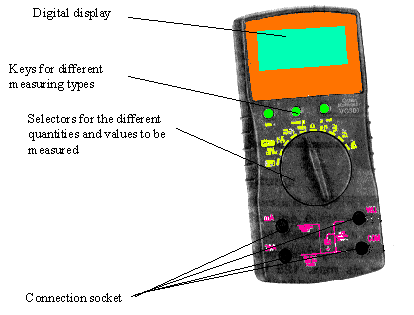|
MODULE V
Electrical engineering - Basics Page 45
|

|
 |
8. Overview, structure and function of measuring instruments, sensors and
arrangement of feelers
8.1 Overview, structure and function of measuring instruments
The following types of measuring instruments can be distinguished:
- Analog
measuring instruments
These measuring instruments indicate the measured value on a scale, mostly
with an indicating needle or a pointer (e.g. pressure manometer). If the to
be measured quantity (e.g. amperage, voltage or temperature) changes, the
position of the indicating needle also changes or, as in case of the mercury
thermometer, the length of the mercury column.
Analog measuring instruments can indicate every value.
- Digital measuring instrument
Digital measuring instruments always indicate the measured values with numbers,
e.g. 0, 1, 2, ... , 8, 9, sometimes also in combination with special characters
like e.g. +, -, %, etc.... These measuring instruments have the advantage
that the measured values can comfortably and easily be read.
The indication of measured quantities and values however, also depends on
the digital display. If e.g. the layout of the display is such that only integers
can be displayed during e.g. a measurement of the voltage, intermediate values
(e.g. 213,5V) can not be indicated.
Furthermore
measuring instruments can be classified according to the type and range of the
measuring possibilities they offer:
- Single-purpose
precision measuring instruments
These devices are designed for the measurement of a single particular quantity
and only have a very small measuring range. With them one can furthermore
normally only measure a fraction of the basic unit.
Example: The basic unit for measuring voltage is Volt [V]. If measurements
in the mini volt range [mV] have to be done, a volt scale can not be used.
Instead a special mini volt scale is necessary which in turn can only show
a particular measuring range, because it otherwise would become too large.
- Multi-purpose precision
measuring instruments (multi-function precision measuring instruments)
These measuring devices can indicate various measured values and quantities
in different device-specific measuring ranges. Corresponding adjustment and
connection possibilities make this possible.
- Single-purpose measuring
instruments
For measurements that have to be frequently repeated and where always the
same values and quantities have to be measured or controlled, usually single-purpose
measuring instruments are used. These inexpensive and easily to handle measuring
devices are normally sufficient for many measurements .
- Multi-purpose measuring
instruments (multi-function measuring instruments - multimeters)
Multi-purpose measuring devices are used if different electric values and
quantities have to be measured which each have different measuring ranges.
Because of the multi-functionality of these devices however also the measuring
error probability is increasing. Measuring errors can e.g. be the result of
wrong device adjustments. So, operating this kind of devices requires increased
attention. Furthermore, multi-purpose measuring devices normally are relatively
more expensive and susceptible to errors than other measuring devices.
With the multi-purpose measuring
instrument (multimeter) shown in diagram 54 voltage, amperage and resistance of
alternating and direct currents can be measured.
Diagram 54: Example for a typical multi-purpose measuring device (multimeter)

